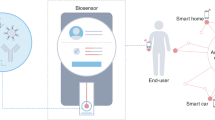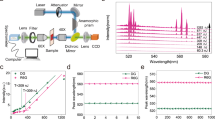Abstract
Biosensing relies on the detection of molecules and their specific interactions. It is therefore highly desirable to develop transducers exhibiting ultimate detection limits. Microcavities are an exemplary candidate technology for demonstrating such a capability in the optical domain and in a label-free fashion. Additional sensitivity gains, achievable by exploiting plasmon resonances, promise biosensing down to the single-molecule level. Here, we introduce a biosensing platform using optical microcavity-based sensors that exhibits single-molecule sensitivity and is selective to specific single binding events. Whispering gallery modes in glass microspheres are used to leverage plasmonic enhancements in gold nanorods for the specific detection of nucleic acid hybridization, down to single 8-mer oligonucleotides. Detection of single intercalating small molecules confirms the observation of single-molecule hybridization. Matched and mismatched strands are discriminated by their interaction kinetics. Our platform allows us to monitor specific molecular interactions transiently, hence mitigating the need for high binding affinity and avoiding permanent binding of target molecules to the receptors. Sensor lifetime is therefore increased, allowing interaction kinetics to be statistically analysed.
This is a preview of subscription content, access via your institution
Access options
Subscribe to this journal
Receive 12 print issues and online access
$259.00 per year
only $21.58 per issue
Buy this article
- Purchase on Springer Link
- Instant access to full article PDF
Prices may be subject to local taxes which are calculated during checkout





Similar content being viewed by others
References
Vollmer, F. & Yang, L. Label-free detection with high-Q microcavities: a review of biosensing mechanisms for integrated devices. Nanophotonics 1, 267–291 (2012).
Washburn, A. L., Gunn, L. C. & Bailey, R. C. Label-free quantitation of a cancer biomarker in complex media using silicon photonic microring resonators. Anal. Chem. 81, 9499–9506 (2009).
Robinson, J. T., Chen, L. & Lipson, M. On-chip gas detection in silicon optical microcavities. Opt. Express 16, 4296–4301 (2008).
Bahl, G. et al. Brillouin cavity optomechanics with microfluidic devices. Nature Commun. 4, 1994 (2013).
Armani, A. M. & Vahala, K. J. Heavy water detection using ultra-high-Q microcavities. Opt. Lett. 31, 1896–1898 (2006).
Vollmer, F. & Arnold, S. Whispering-gallery-mode biosensing: label-free detection down to single molecules. Nature Methods 5, 591–596 (2008).
Lu, T. et al. High sensitivity nanoparticle detection using optical microcavities. Proc. Natl Acad. Sci. USA 108, 5976–5979 (2011).
Vollmer, F., Arnold, S. & Keng, D. Single virus detection from the reactive shift of a whispering-gallery mode. Proc. Natl Acad. Sci. USA 105, 20701–20704 (2008).
Shao, L. et al. Detection of single nanoparticles and lentiviruses using microcavity resonance broadening. Adv. Mater. 25, 5616–5620 (2013).
Zhu, J. G. et al. On-chip single nanoparticle detection and sizing by mode splitting in an ultrahigh-Q microresonator. Nature Photon. 4, 46–49 (2010).
Lin, S. Y., Schonbrun, E. & Crozier, K. Optical manipulation with planar silicon microring resonators. Nano Lett. 10, 2408–2411 (2010).
Mandal, S., Serey, X. & Erickson, D. Nanomanipulation using silicon photonic crystal resonators. Nano Lett. 10, 99–104 (2010).
Santiago-Cordoba, M. A., Boriskina, S. V., Vollmer, F. & Demirel, M. C. Nanoparticle-based protein detection by optical shift of a resonant microcavity. Appl. Phys. Lett. 99, 073701 (2011).
Swaim, J. D., Knittel, J. & Bowen, W. P. Detection limits in whispering gallery biosensors with plasmonic enhancement. Appl. Phys. Lett. 99, 243109 (2011).
Foreman, M. R. & Vollmer, F. Theory of resonance shifts of whispering gallery modes by arbitrary plasmonic nanoparticles. New J. Phys. 15, 083006 (2013).
Dantham, V. R. et al. Label-free detection of single protein using a nanoplasmonic–photonic hybrid microcavity. Nano Lett. 13, 3347–3351 (2013).
Santiago-Cordoba, M. A., Cetinkaya, M., Boriskina, S. V., Vollmer, F. & Demirel, M. C. Ultrasensitive detection of a protein by optical trapping in a photonic–plasmonic microcavity. J. Biophoton. 5, 629–638 (2012).
Cooper, M. A. Optical biosensors in drug discovery. Nature Rev. Drug Discov. 1, 515–528 (2002).
Fan, X. D. et al. Sensitive optical biosensors for unlabeled targets: a review. Anal. Chim. Acta 620, 8–26 (2008).
Sassolas, A., Leca-Bouvier, B. D. & Blum, L. J. DNA biosensors and microarrays. Chem. Rev. 108, 109–139 (2008).
Ndieyira, J. W. et al. Surface-stress sensors for rapid and ultrasensitive detection of active free drugs in human serum. Nature Nanotech. 9, 225–232 (2014).
Zijlstra, P., Paulo, P. M. R. & Orrit, M. Optical detection of single non-absorbing molecules using the surface plasmon resonance of a gold nanorod. Nature Nanotech. 7, 379–382 (2012).
Zheng, G. F., Patolsky, F., Cui Y., Wang, W. U. & Lieber, C. M. Multiplexed electrical detection of cancer markers with nanowire sensor arrays. Nature Biotechnol. 23, 1294–1301 (2005).
Xuexin, D. et al. Quantification of the affinities and kinetics of protein interactions using silicon nanowire biosensors. Nature Nanotech. 7, 401–407 (2012).
Ament, I., Prasad, J., Henkel, A., Schmachtel, S. & Sonnichsen, C. Single unlabeled protein detection on individual plasmonic nanoparticles. Nano Lett. 12, 1092–1095 (2012).
Wu, Y., Zhang, D. Y., Yin, P. & Vollmer, F. Ultraspecific and highly sensitive nucleic acid detection by integrating a DNA catalytic network with a label-free microcavity. Small 10, 2067–2076 (2014).
Sorgenfrei, S. et al. Label-free single-molecule detection of DNA-hybridization kinetics with a carbon nanotube field-effect transistor. Nature Nanotech. 6, 125–131 (2011).
He, L. N., Ozdemir, K., Zhu, J. G., Kim, W. & Yang, L. Detecting single viruses and nanoparticles using whispering gallery microlasers. Nature Nanotech. 6, 428–432 (2011).
Foreman, M. R., Jin, W. & Vollmer, F. Optimizing detection limits in whispering gallery mode biosensing. Opt. Express 22, 5491–5511 (2014).
Foreman, M. R. & Vollmer, F. Level repulsion in hybrid photonic–plasmonic microresonators for enhanced biodetection. Phys. Rev. A 88, 023831 (2013).
Baaske, M. & Vollmer, F. Optical resonator biosensors: molecular diagnostic and nanoparticle detection on an integrated platform. ChemPhysChem 13, 427–436 (2012).
Prodan, E., Radloff, C., Halas, N. J. & Nordlander, P. A hybridization model for the plasmon response of complex nanostructures. Science 302, 419–422 (2003).
Huang, X. H., Neretina, S. & El-Sayed, M. A. Gold nanorods: from synthesis and properties to biological and biomedical applications. Adv. Mater. 21, 4880–4910 (2009).
Kaplan, A. et al. Finite element simulation of a perturbed axial-symmetric whispering-gallery mode and its use for intensity enhancement with a nanoparticle coupled to a microtoroid. Opt. Express 21, 14169–14180 (2013).
Knittel, J., Swaim, J. D., McAuslan, D. L., Brawley, G. A. & Bowen, W. P. Back-scatter based whispering gallery mode sensing. Sci. Rep. 3, 2974 (2013).
Swaim, J. D., Knittel, J. & Bowen, W. P. Tapered nanofiber trapping of high-refractive-index nanoparticles. Appl. Phys. Lett. 103, 203111 (2013).
Zhu, J. G., Ozdemir, S. K. & Yang, L. Optical detection of single nanoparticles with a subwavelength fiber-taper. IEEE Photon. Technol. Lett. 23, 1346–1348 (2011).
Wilson, K. A., Finch, C. A., Anderson, P., Vollmer, F. & Hickman, J. J. Whispering gallery mode biosensor quantification of fibronectin adsorption kinetics onto alkylsilane monolayers and interpretation of resultant cellular response. Biomaterials 33, 225–236 (2012).
Arnold, S., Ramjit, R., Keng, D., Kolchenko, V. & Teraoka, I. MicroParticle photophysics illuminates viral bio-sensing. Faraday Discuss. 137, 65–83 (2008).
Topolancik, J. & Vollmer, F. Photoinduced transformations in bacteriorhodopsin membrane monitored with optical microcavities. Biophys. J. 92, 2223–2229 (2007).
Noto, M., Vollmer, F., Keng, D., Teraoka, I. & Arnold, S. Nanolayer characterization through wavelength multiplexing of a microsphere resonator. Opt. Lett. 30, 510–512 (2005).
Lutti, J., Langbein, W. & Borri, P. A monolithic optical sensor based on whispering-gallery modes in polystyrene microspheres. Appl. Phys. Lett. 93, 151103 (2008).
Collot, L., Lefevreseguin, V., Brune, M., Raimond, J. M. & Haroche, S. Very high-Q whispering gallery mode resonances observed on fused-silica microspheres. Europhys. Lett. 23, 327–334 (1993).
Gorodetsky, M. L., Savchenkov, A. A. & Ilchenko, V. S. Ultimate Q of optical microsphere resonators. Opt. Lett. 21, 453–455 (1996).
Gorodetsky, M. L. & Ilchenko, V. S. Optical microsphere resonators: optimal coupling to high-Q whispering-gallery modes. J. Opt. Soc. Am. B 16, 147–154 (1999).
Mazzei, A., Gotzinger, S., Menezes, L. D., Sandoghdar, V. & Benson, O. Optimization of prism coupling to high-Q modes in a microsphere resonator using a near-field probe. Opt. Commun. 250, 428–433 (2005).
Walker, D. A., Leitsch, E. K., Nap, R. J., Szleifer, I. & Grzybowski, B. A. Geometric curvature controls the chemical patchiness and self-assembly of nanoparticles. Nature Nanotech. 8, 676–681 (2013).
Shi, D., Song, C., Jiang, Q., Wang, Z-G. & Ding, B. A facile and efficient method to modify gold nanorods with thiolated DNA at a low pH value. Chem. Commun. 49, 2533–2535 (2013).
Acknowledgements
The authors acknowledge financial support for this work from the Max Planck Society (M.D.B. and F.V.) and the Alexander von Humboldt Foundation (M.R.F.).
Author information
Authors and Affiliations
Contributions
F.V. and M.D.B. conceived and planned the experiments. M.D.B. conducted experimental work and data analysis. M.R.F. performed numerical and theoretical analysis. F.V., M.R.F. and M.D.B. wrote the manuscript.
Corresponding author
Ethics declarations
Competing interests
The authors declare no competing financial interests.
Supplementary information
Supplementary information
Supplementary Information (PDF 6856 kb)
Rights and permissions
About this article
Cite this article
Baaske, M., Foreman, M. & Vollmer, F. Single-molecule nucleic acid interactions monitored on a label-free microcavity biosensor platform. Nature Nanotech 9, 933–939 (2014). https://doi.org/10.1038/nnano.2014.180
Received:
Accepted:
Published:
Issue Date:
DOI: https://doi.org/10.1038/nnano.2014.180
This article is cited by
-
An H-Shaped Exposed Core Surface Plasmon Resonance Sensor and Detection of Cancer Cells
Plasmonics (2024)
-
A whispering-gallery scanning microprobe for Raman spectroscopy and imaging
Light: Science & Applications (2023)
-
Multimode sensing based on optical microcavities
Frontiers of Optoelectronics (2023)
-
Demonstration of intracellular real-time molecular quantification via FRET-enhanced optical microcavity
Nature Communications (2022)
-
Evanescent scattering imaging of single protein binding kinetics and DNA conformation changes
Nature Communications (2022)



